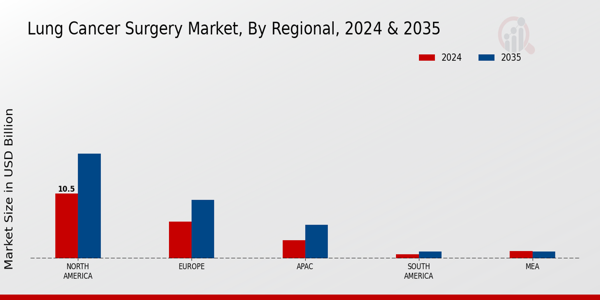Rising Incidence of Lung Cancer
The increasing incidence of lung cancer is a primary driver for the Lung Cancer Surgery Market. According to recent statistics, lung cancer remains one of the most prevalent cancers worldwide, with millions diagnosed annually. This surge in cases necessitates a corresponding rise in surgical interventions, as early-stage lung cancer often requires surgical resection for optimal outcomes. The demand for surgical procedures is further amplified by the aging population, which is more susceptible to various forms of cancer. As healthcare systems strive to address this growing challenge, investments in surgical facilities and technologies are likely to increase, thereby propelling the Lung Cancer Surgery Market forward.
Emergence of Personalized Medicine
The emergence of personalized medicine is reshaping the Lung Cancer Surgery Market. Tailoring treatment plans based on individual genetic profiles and tumor characteristics allows for more effective surgical interventions. This approach not only enhances the efficacy of surgeries but also minimizes the risk of recurrence. As research continues to unveil the complexities of lung cancer, the integration of personalized treatment strategies is becoming increasingly prevalent. Pharmaceutical companies and research institutions are collaborating to develop targeted therapies that complement surgical options, thereby improving overall patient outcomes. This shift towards personalized medicine is likely to drive growth in the Lung Cancer Surgery Market, as it aligns with the broader trend of individualized healthcare.
Advancements in Surgical Techniques
Innovations in surgical techniques are significantly influencing the Lung Cancer Surgery Market. The adoption of minimally invasive procedures, such as video-assisted thoracoscopic surgery (VATS) and robotic-assisted surgeries, has transformed traditional approaches to lung cancer treatment. These advanced techniques not only reduce recovery times but also minimize complications, making surgery a more appealing option for patients. As healthcare providers increasingly embrace these technologies, the market is expected to witness substantial growth. Furthermore, the integration of imaging technologies and navigation systems enhances surgical precision, which is crucial for successful outcomes in lung cancer surgeries. This trend indicates a promising future for the Lung Cancer Surgery Market.
Growing Awareness and Screening Programs
The rising awareness of lung cancer and the implementation of screening programs are pivotal factors driving the Lung Cancer Surgery Market. Public health initiatives aimed at educating individuals about the risks associated with lung cancer have led to earlier detection and diagnosis. Programs such as low-dose computed tomography (LDCT) screening have proven effective in identifying lung cancer at its nascent stages, thereby increasing the likelihood of surgical intervention. As more individuals participate in these screening programs, the demand for surgical procedures is expected to rise. This proactive approach to lung cancer management not only enhances patient outcomes but also stimulates growth within the Lung Cancer Surgery Market.
Increased Investment in Healthcare Infrastructure
Investment in healthcare infrastructure is a crucial driver for the Lung Cancer Surgery Market. Governments and private entities are increasingly allocating resources to enhance surgical facilities and improve access to advanced treatment options. This trend is particularly evident in regions where healthcare systems are evolving to meet the demands of rising cancer rates. Enhanced surgical centers equipped with state-of-the-art technology facilitate more effective lung cancer surgeries, thereby attracting a larger patient base. Additionally, the establishment of specialized cancer treatment centers is likely to foster collaboration among healthcare professionals, further advancing the quality of care. Such developments are expected to bolster the Lung Cancer Surgery Market significantly.


















Leave a Comment